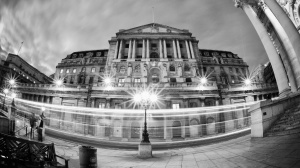
With markets primed for a Bank of England interest rate rise as soon as next week, UK policymakers now start to face an uncomfortable entanglement of monetary and fiscal policy bequeathed by central bank bond buying, or 'quantitative easing'.
Wednesday sees UK finance minister Rishi Sunak lay out his latest government budget, likely relieved by lower borrowing estimates than initially forecast after the pandemic hit but also under pressure to outline a framework for stabilising public finances medium term.
However, the BoE's rhetorical twist over the past month has guided money markets to expect a rise in its historically low 0.1% policy rate by yearend as inflation expectations build. And it now exposes a long-running debate about how vulnerable UK government debt is to higher rates.
The Office for Budget Responsibility - the British government's own budget watchdog - has flagged the problem all year and stresses the pressure higher interest rates present the government's vast debt pile - which at 100% of national output is three times levels 20 years ago.
And the financial exposure to Treasury of higher short-term interest rates raises worries for many observers about central bank autonomy and the willingness to tackle inflation should it become a problem. The BoE only gained operational independence from government as recently as 1997 but still reports to the Treasury, which also dictates its inflation target.
In essence, the problem involves the maturity mismatch due to years of on-off QE programmes that have lifted the BoE's balance sheet since the 2008 banking crash and again since the pandemic - mainly to keep a lid on long-term borrowing costs.
QE involves the purchase of mostly gilts from commercial banks in return for interest-bearing reserves at the central bank rather than cash per se. And the floating interest rate on those bank reserves is the 'Bank Rate' the BoE uses to adjust its overall monetary policy.
Raising short-term interest rates with a trillion dollar balance sheet has its problems for central bank and government alike.
As interest rates tumble, it was win-win. Not only are debt servicing costs capped, but there's a major windfall for the central bank as it pays out a lower interest rate on bank reserves than it receives on the longer-term debts on its balance sheet. And it sent those profits back to the Treasury.
Earlier this year, the OBR estimated that to date the positive cash flow alone from the Bank of England's so-called Asset Purchase Facility to the Treasury totalled 113 billion pounds ($156 billion)
But all that gets turned on its head when the Bank Rate starts to rise - most likely faster than long-term rates - and especially if the yield curve were to invert. The Treasury indemnifies all BoE losses.
UPSIDE DOWN
The OBR estimates that almost a third of gross government debt - or 875 billion pounds ($1.2 trillion) - will be held in the form of bank reserves by the end of next year. Market pricing already has the Bank Rate nine times higher than it is today - a rise to about 90 basis points from 0.1%.
The cost of a one percentage point rise in interest rates across the spectrum on consolidated public sector liabilities would be as much as half a percent of GDP within 12 months.
Another implication is that instead of outstanding gilts having the longest median maturity of the G7 at more than 14 years, the consolidated public debts have a median maturity of just 2 years - dangerous in any period of protracted interest rate rises.
According to the OBR, this new scenario - along with the fact that about a quarter of UK government debt is now inflation protected - also means a burst of inflation no longer has the positive effect on debt ratios that it had several decades ago.
In an article published by VoxEU this week, economists Charles Goodhart and Manoj Pradhan - authors of a 2020 book arguing a structural revival of global inflation was underway - reckon central banks need to be careful about sudden and destabilising policy reversals to restore credibility even if inflation persists.
But they warn the persistence of large central bank balance sheets in a period of rising interest rates raises all sorts of political questions about paying commercial banks larger and larger returns on reserves and also about how much Bank policy costs Treasury directly.
"At a time of worsening debt service ratios, the need for increased taxation and the transfer of increasingly large payments from the public purse to commercial banks for holding reserves at the central bank will become increasingly politically unpopular," they wrote. "You do not have to be a populist politician to see how this conjuncture could become ... difficult to defend."
"Central banks will have to bear capital losses on their holdings and could need recapitalisation from governments," Goodhart and Pradhan added. "That process will have to be structured in a way that does not raise questions about central bank independence."
There are some offering solutions. Economists at the independent UK think tank the National Institute of Economic and Social Research in July said Treasury and central bank should reduce the maturity mismatch by swapping longer-dated gilts back to Treasury to reduce the duration of its portfolios.
"Our proposal aims to limit even the appearance of conflicts between the Treasury and the central bank when macroeconomic policies have to tighten," they wrote.
(by Mike Dolan, Twitter: @reutersMikeD)
Thanks for signing up to Minutehack alerts.
Brilliant editorials heading your way soon.
Okay, Thanks!

